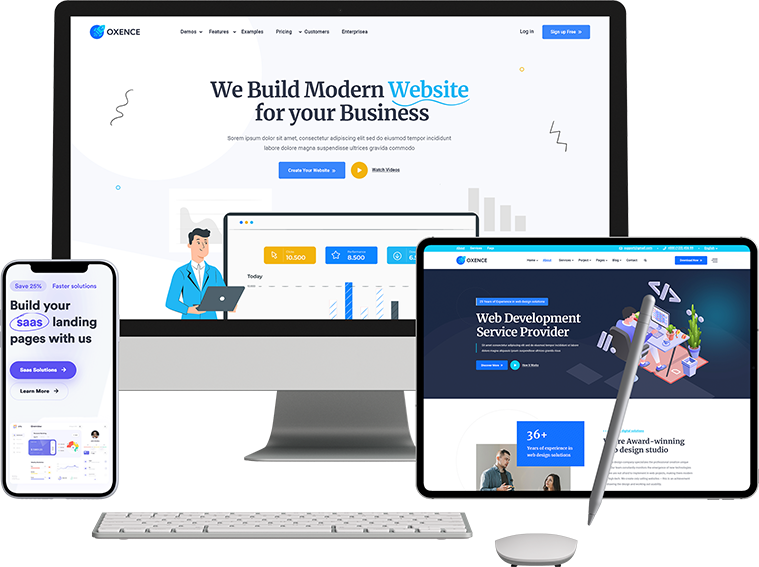We are White label
website design agency
10+ Years Of Experience In Website Design & Development
At Coxtim, we offer white label website design services to other companies. Our team of experienced web designers and developers can create custom websites for your clients or for your own brand, without any visible branding or logo from Coxtim. This allows you to present the website as your own and offer a seamless experience to your clients. We work closely with you to understand your requirements and provide solutions that meet your needs. Our white label website design services include responsive design, e-commerce websites, custom web applications, and more. Contact us today to learn more about our white label website design services and how we can help your business grow.
- Responsive Website Design
- User Experience Design
- CMS and e-Commerce Integration
- Website Content Strategy
- Cross Browser and Platform Testing
- Responsive Website Design
- Usability and Competition Analysis
Make Strategy
Determine what you want to achieve with your business.
Website Design
This involves understanding the client's goals, target audience, and competition.
Development
This involves creating the user interface and visual elements of the website using HTML, CSS, and JavaScript
Project Testing
This involves running the test cases and recording the test results. It includes functional testing, performance testing, security testing, and user acceptance testing.
Project Lunch
Before launching the project, it is important to conduct thorough testing to ensure that it functions properly and is free of defects.

HTML, CSS & WordPress Development
- Design and planning: This involves creating a visual design for the website and planning its structure and content.
- HTML and CSS development: This involves using HTML and CSS to create the structure and visual presentation of the website.
- WordPress integration: This involves integrating the HTML and CSS into a WordPress theme or plugin, which can then be used to build the website.
- Testing and debugging: This involves testing the website to ensure that it functions properly and is free of errors.
- Launch and maintenance: This involves launching the website and ensuring that it is properly maintained over time, with updates to content and software as needed.
Design For Any Device Responsive Web Design
Responsive web design is an approach to web design that focuses on creating websites that provide an optimal user experience across a wide range of devices, including desktop computers, laptops, tablets, and smartphones. With responsive web design, the layout and content of the website adjusts dynamically based on the screen size and resolution of the device.
When designing for any device with responsive web design, there are several important considerations to keep in mind:
- Mobile-first design: It is important to design for mobile devices first, as they often have more limited screen space and require simplified navigation.
- Flexible grid systems: Using a flexible grid system can help ensure that the website layout adapts to different screen sizes and resolutions.
- Scalable images: Using images that can be scaled up or down based on the device screen size can help ensure that the website loads quickly and is visually appealing on all devices.
- Clear and simple navigation: The website navigation should be clear and simple, with easy-to-use menus and navigation links.
- Content prioritization: It is important to prioritize the most important content on the website, especially for mobile devices where screen space is limited.


Very Much 91.50% Increase in Organic Traffic
A 91.50% increase in organic traffic means that there has been a significant improvement in the amount of traffic coming to a website through search engine results, without paid advertising or other promotional efforts. This increase can be attributed to a number of factors, such as improved search engine optimization (SEO), content marketing, and social media engagement.
-
Keyword research: Identifying the most relevant and valuable keywords for the website’s target audience, and using them strategically in content and metadata. - On-page optimization: Ensuring that the website’s pages are properly structured and optimized for search engine crawlers, including title tags, meta descriptions, and header tags.
- Content creation: Developing high-quality, relevant, and engaging content that is optimized for search engine visibility and user engagement.
- Link building: Building high-quality inbound links from reputable sources to improve the website’s authority and visibility in search engine results.
- Social media engagement: Building a strong social media presence and engaging with users on social media platforms to improve brand awareness and drive traffic to the website.
Marketing to Support Your Web Design
Search Engine Optimization (SEO)
SEO involves optimizing your website's content and structure to rank higher in search engine results. This can help increase the visibility and credibility of your website among potential customers.
Content Marketing
Content marketing involves creating and sharing valuable, relevant, and consistent content to attract and retain a clearly defined audience. This can help build brand awareness and establish your company as a thought leader in your industry.
Pay-Per-Click (PPC) Advertising
PPC advertising involves placing ads on search engines and other websites, and paying only when a user clicks on the ad. This can help drive targeted traffic to your website and increase conversions.
Email Marketing
Email marketing involves sending targeted emails to your subscribers to promote your products or services, share relevant content, and drive traffic to your website.



Years Of Experience
Asked Questions about White label website design.
ebsite design is the process of creating and designing the layout, structure, and appearance of a website. It involves designing the visual elements, such as the color scheme, typography, images, and graphics, as well as the functional elements, such as the navigation, user interface, and user experience.
Website design is important because it affects how users perceive your website and your brand. A well-designed website can improve user experience, increase engagement, and drive conversions. It can also help establish credibility and professionalism for your brand.
When designing a website, it's important to consider factors such as user experience, mobile responsiveness, branding, navigation, site structure, content, and search engine optimization. These factors can help ensure that your website is effective in achieving its goals and meeting the needs of your target audience.
The time it takes to design a website depends on several factors, such as the size and complexity of the website, the number of features and functionalities required, and the availability of resources. Generally, a basic website can be designed in a few weeks, while more complex websites can take several months.
The cost of website design varies depending on several factors, such as the size and complexity of the website, the number of features and functionalities required, and the level of customization. Basic website design can cost anywhere from a few hundred to a few thousand dollars, while more complex websites can cost tens of thousands of dollars.
Yes, it's possible to design your own website using website builders and content management systems such as WordPress, Squarespace, Wix, or Shopify. However, it's important to have a good understanding of website design principles and best practices to ensure that your website is effective and meets the needs of your target audience.
Best Package For Responsive Web Design
Basic Plan
- Landing page design (1 pages)
- HTML+CSS design (6 pages)
- Online support (24/7)
- Social Media Marketing
- WordPres development
- 4 Days Delivery
- 5 Revisions
Standard Plan
- Landing page design (2 pages)
- HTML+CSS design (8 pages)
- Online support (24/7)
- Social Media Marketing
- WordPres development
- 7 Days Delivery
- 7 Revisions
Premium Plan
- Landing page design (3 pages)
- HTML+CSS design (10 pages)
- Online support (24/7)
- Social Media Marketing
- WordPres development
- 10 Days Delivery
- 10 Revisions
Checkout Our Website Design & Development Services
- Minimalist design: a simple and clean design with minimal elements and features.
- Flat design: a design style that uses simple two-dimensional elements and bright colors.
- Material design: a design style that uses shadows and depth to create a realistic and tactile user interface.
- Responsive design: a design that adjusts and optimizes the layout for different screen sizes and devices.
- Parallax design: a design that creates an illusion of depth by using scrolling and overlapping elements.
- One-page design: a design that fits all the content on a single page, with sections navigated via scrolling or links.
- Typography-focused design: a design that emphasizes typography, using creative fonts and typography hierarchy to draw attention.
- Illustration-focused design: a design that uses illustrations to convey a message or story.
- Image-focused design: a design that uses large, high-quality images to create an immersive experience.
- Interactive design: a design that encourages user engagement through animations, videos, and interactive elements.
- Storytelling design: a design that uses a narrative structure to tell a story or convey information.
- E-commerce design: a design that focuses on optimizing the user experience for buying products online.
- Blog design: a design that focuses on displaying blog posts and encouraging user engagement through comments and social sharing.
- Portfolio design: a design that showcases the work of an artist, designer, or photographer.
- Magazine design: a design that organizes content in a way that mimics a traditional print magazine, with sections and features.
- Landing page design: a design that is focused on encouraging a user to take a specific action, such as signing up for a newsletter or downloading an ebook.
- Video background design: a design that uses a video background to create an immersive and engaging experience.
- App-focused design: a design that promotes and encourages app downloads, with links to app stores and features specific to mobile devices.


